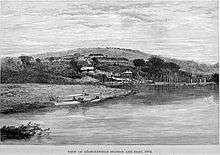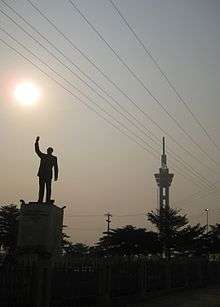History of Kinshasa
While the modern city of Kinshasa has its roots in the 1881 establishment of Léopoldville by Belgian settlers, human settlement in the Kinshasa area has stretched back to at least the 1st millennium BC. In the Pool Malebo area, the Tio (or Bateke) populated the right side (north) of the river and others assimilated with the Téké culture (Humbu and Mfinu peoples) resided on the left side (south) of the river. The region was an area where the slave trade and ivory trade played a significant role in the economy, and enriched the Tio Kingdom.
16th-17th centuries

From the 16th to 17th century, the Pool region became an important hub between the river and coastal areas. Vegetables of the Americas were also introduced to the interior of the continent through trade; slaves (most often the losers in various conflicts) were travelling to Loango, the mouth of the river and south of the Kongo Kingdom. The Bobangis, sometimes called Bangala (people of the river), occupied the major part of trade with the equatorial region in navigating the river and its river to the villages Téké Pool.
During the eighteenth and nineteenth centuries of mostly fishermen and traders from the north Teke install markets and villages in the southern Pool Malebo and on the board that will appoint the latest Batéké plateau. The tribes of the region, Humbu and Mfinu, were regarded as owners on this side of the river. Over time, the settlers Téké cause local farther shore, to the interior of the hills. The main Téké villages of the south shore were Nsasa with around 5000 inhabitants, Ntambo with less than 3000 inhabitants. Lemba, among a multitude of small villages humbu, was the capital market and political Humbu, with about 300 residents. The markets saw River caravans slave holders of oil, almonds, palm, peanuts, sesame and ivory come and go.
Colonial Léopoldville

.png)
The city was founded as a trading post by Henry Morton Stanley in 1881 and named Léopoldville in honor of King Léopold II of Belgium, who controlled the vast territory that is now the Democratic Republic of the Congo, as a colony. The post flourished as the first navigable port on the Congo River above Livingstone Falls, a series of rapids over 300 km below Leopoldville. At first, all goods arriving by sea or being sent by sea had to be carried by porters between Léopoldville and Matadi, the port below the rapids and 150 km from the coast. The completion of the Matadi-Kinshasa portage railway in 1898 provided a faster and more efficient alternative route around the rapids and sparked the rapid development of Léopoldville. In 1926, the city was elevated to capital of the Belgian Congo, replacing the town of Boma in the Congo estuary.
It is "highly likely" that the HIV/AIDS pandemic started at Kinshasa around 1920 according to a research of University of Oxford.[1]
Kinshasa under Mobutu

When the Belgian Congo became independent of Belgium in 1960, Dutch was dropped as an official language and so was the alternative name Leopoldstad. In 1965 Mobutu Sese Seko seized power in the Congo in his second coup and initiated a policy of "Africanizing" the names of people and places in the country. In 1966, Léopoldville was renamed Kinshasa for a village named Kinchassa that once stood near the site. The city grew rapidly under Mobutu, drawing people from across the country who came in search of their fortunes or to escape ethnic strife elsewhere. This inevitably brought about a change to the city's ethnic and linguistic composition as well. Although it is situated in territory that traditionally belongs to the Bateke and Bahumbu people, the lingua franca in Kinshasa today is Lingala.[2]
In 1974, Kinshasa hosted the 'Rumble in the Jungle' boxing match between Muhammad Ali and George Foreman, in which Ali defeated Foreman to regain the World Heavyweight title.
Kinshasa suffered greatly due to Mobutu's excesses, mass corruption, nepotism and the civil war that led to his downfall. .
Kinshasa post-Mobutu
On May 20, 1997, after the First Congo War, Laurent-Désiré Kabila triumphantly marched with his rebel forces to take control of the country's capital after Mobutu fled into exile in France. However, the city was later nearly taken over by other rebels backed by Uganda and Rwanda during the earlier part of the Second Congo War. It was very recently the scene of fighting between loyalists of Jean-Pierre Bemba and Joseph Kabila following the 2006 general elections; 600 people, including untold numbers of civilian bystanders were killed or wounded.
See also
- Timeline of Kinshasa
- Urban history of Kinshasa (in French)
References
- ↑ "HIV pandemic's origins located". University of Oxford. 3 October 2014. Retrieved 9 July 2016.
- ↑ Mukenge, Tshilemalema ; Culture and customs of the Congo, Culture and customs of Africa; Greenwood Publishing Group, 2002; ISBN 0-313-31485-3, ISBN 978-0-313-31485-8; pg. 72-75
External links
![]() Media related to History of Kinshasa at Wikimedia Commons
Media related to History of Kinshasa at Wikimedia Commons